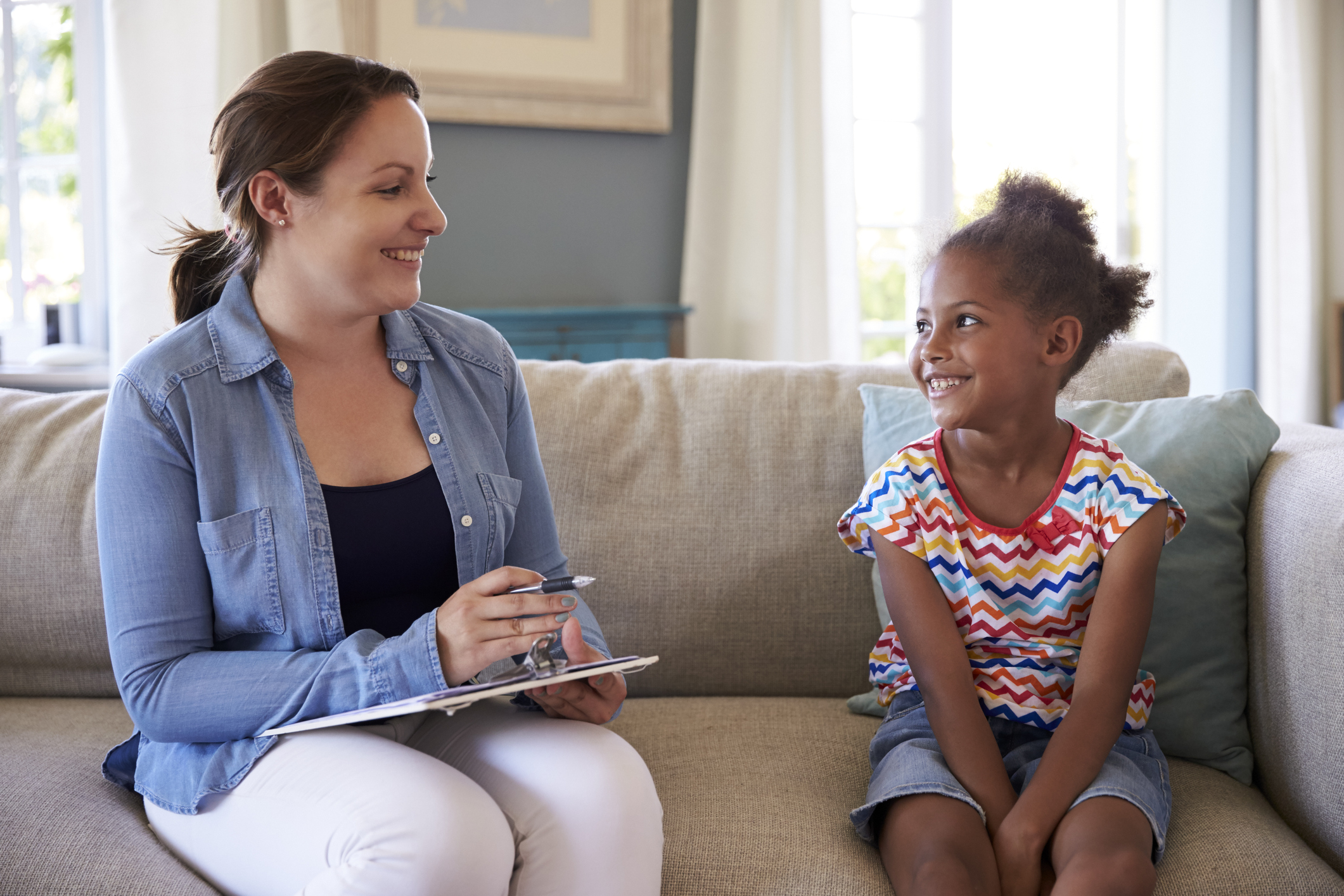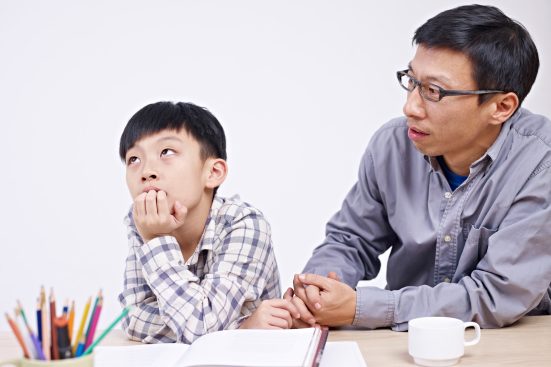One of the most important ways therapists help children with anxiety symptoms is a technique called “exposure”. This article provides a brief introduction to exposure and how therapists might use it with kids who experience anxiety.
Definitions
Exposure is defined as a “controlled therapeutic technique which involves a child being in the presence of an anxiety-provoking stimulus or situation” (Marks 1973).
In other words, a child who is anxious about insects might spend some time, with the support of a therapist or a parent, looking at or touching a moth or other insect. Sometimes this is done after a child has some “coping strategies” to manage their anxiety in the exposure situation.
Exposure can be done in a variety of ways. Here are some of the definitions therapists might use:
In-vivo exposure – this is the primary form of exposure referred to in the definition above – that is, it is when a child is exposed to the anxiety provoking stimulus/situation in “real life”. Another example might be a child with a fear of public toilets being taken to a public toilet with their therapist/parent.
Imaginal exposure – this is a form of exposure where the child imagines the feared situation, memory or worry (eg a child with fears of being negatively evaluated by others at school vividly imagines doing a talk in front of the class).
Interoceptive exposure – this is a form of exposure where a child is exposed to feared bodily sensations (eg a child with fear of panic symptoms such as dizziness and heart racing, would be helped to deliberately hyperventilate in order to be exposed to those panic symptoms).
Graded exposure – this refers to exposure which is done gradually and systematically, usually from least to most feared (eg a child with a fear of being away from a parent working up a hierarchy of spending time further and further away from a parent, for longer and longer time periods).
Flooding – this refers to exposure which happens in a longer or more intense way (eg a child with a fear of dogs spending a day in a doggy day care centre).
Virtual reality exposure- this is when a therapist uses virtual reality technology to expose the child to feared situation (eg a child with a fear of flying using a VR headset to be in a plane).
Systematic desensitization – when exposure is combined with relaxation techniques (eg a child with a fear of the dark, being in a gradually dimmed room while practicing relaxing their body at the same time).
Exposure and Response Prevention – usually considered to be a treatment component of Obsessive Compulsive Disorder (OCD), and refers to when we ask a child to be exposed to distressing situations/images/ideas while “preventing” them from using compulsions to manage the anxiety they experience from those images/ideas (eg touching a germy surface without washing hands, imagining a scary situation without immediately counting to 10).
Does exposure help?
Research suggests that for children (this is true for adults too) with anxiety disorders and symptoms, treatments for children with anxiety disorders which include exposure are more effective than those which don’t. Some research suggests the more exposure included in a treatment, the more effective the treatment is in reducing symptoms of anxiety.
What is going on which makes exposure helpful?
Psychologists initially thought exposure helped because of a concept called “habituation”. Habituation means that people have a reduced response to a stimulus if that stimulus is repeatedly presented. In other words, if a person has a “fear response” to a situation, but is then in the presence of that situation for a long time, then their “fear response” will gradually reduce. This is called “habituating”.
However, psychologists have now realized that habituation is not a great explanation of why exposure is effective. This is because experiments found that people (including children) often experienced a lowering of their fear response AFTER the exposure session is over EVEN IF they don’t report any reductions in fear during exposure. In other words, they didn’t habituate to the fear during the exposure – but it seemed to help anyway!
New theories of exposure
Alternative and newer theories for explaining why exposure is often helpful in reducing anxiety have been referred to in several ways, but one term for this is an “Information processing model”.
The core idea is that exposure is helpful not because the fear response becomes habituated after a long or repeated exposure to the feared situation/thing, but instead that it is helpful because through exposure people “learn” different expectations about what will happen when they are with the feared situation/thing.
In other words, exposure works because children learn that the feared stimulus is not as threatening or terrible as they previously thought, or that they can cope with it better than they thought. This new set of “expectations” can then “compete” with the old set of expectations.
For example, a child who is anxious about going to sleep outside of Mum’s bed and believes “I won’t be able to get to sleep anywhere else and this will be awful” and then has repeated experiences of falling asleep in other rooms, now has new expectations which can compete with old expectations, and this is the reason for their reduced anxiety.
What do psychologists do exactly when using exposure with a child who is anxious? (And how might you apply this yourself?)
Below are some of the key steps that are often used by therapists for children with anxiety symptoms. These steps might also be possible for parents/caregivers to use with some children at home, depending on the child, their anxiety and the family situation.
1. Build a trusting therapeutic relationship
For a child (or an adult) to feel safe and supported enough to face something that is extremely scary for them, it is important that a strong and trusting relationship is first built up between the child and the therapist, as well as the parent(s) and therapist. Therefore, the therapist may spend time initially using conversation, play and activities before embarking on using exposure.
2. Provide clear and comprehensive exposure psycho-education to children and families
Before beginning the process of exposure, it is important that the therapist provides children and their families with clear information about why exposure is important and what it will be like. This might include three key topics.
a) Psycho-education about the “anxiety/avoidance loop”
The therapist will likely first provide an age appropriate explanation about how avoidance leads to increased anxiety, often incorporating visuals such as pictures or diagrams.
For a young child, this may be something like:
“When we stay away from or try not to think about things which seem a bit scary, our danger checker learns – that IS a dangerous thing! We get more and more scared”
For older children, they might use more sophisticated language and include information about the brain and body systems that are activated during the anxiety and avoidance cycle.
b) Psycho-education about the “approach/lower anxiety loop”
The therapist may also explain the opposite loop, in other words that “approaching” or using exposure can reduce anxiety.
For example, for younger children they may say:
“When we act in brave ways even when we are scared, our danger checker learns instead that we are safe.”
Again, for older children, they may incorporate more sophisticated information about scientific evidence and processes such as “approach behaviours”, “exposure” or relevant brain structures.
c) Psycho-education about treatment practices
Before embarking on exposure therapy for anxiety, therapists will talk with families about what the treatment of exposure might look like (and that kids might find it tricky), the homework that will be required in between sessions (which is essential), how long it might take to see reductions in anxiety during exposure and what might be some of the tricky parts of completing exposure.
The therapist may take time with parents/caregivers to identify and plan for things they anticipate may be hardest for them about their child’s low motivation/high distress and what specific plans they themselves can put in place to assist them and help ensure it is completed. The therapist may also help the parents/caregivers consider whether they feel able to follow these through and whether they want to proceed.
3. Working out what (exactly) the child is avoiding
To set up exposure exercises, therapists will need to try to identify the specific feared situations or images which the child has typically avoided.
The therapist may need to ask a number of questions to elicit specific examples of situations or images the child is avoiding, rather than just identifying general concepts they may be anxious about.
They may ask questions such as:
If you weren’t at all anxious in situation x/y/z, what would you be doing or saying?
What types of situations are hardest?
When is it worse/when is it better?
The therapist may also explore things the child dislikes or is uncomfortable about. This can be helpful as many children find it difficult to identify lower levels of anxiety – and instead talk about “dislike”.
For example, they may make statements such as:
I don’t like being around dogs/I prefer to use my own toilet at home/I don’t like foods which are chewy/I just don’t like to think about that
It can help to understand that sometimes dislike/discomfort can also be a sign of anxiety and avoidance and that these things might be options for exposure exercises.
4. Identify what a child is worried about when being in these specific situations
Another important step in designing the exposure exercises is to try to find out any particular reasons which make a child worried – or their “negative expectations” about their feared situations.
For example, for a child with a fear of eating green foods, their reasons or negative expectations might be “I will vomit if I eat broccoli”.
For a child with a fear of speaking in class, their reasons or negative expectations might be “People will think I am stupid if I blush while I am doing my presentation”.
This can be difficult for children to identify, particularly for young children, so the therapist may ask questions to try to determine what they fear will happen, such as:
And what will happen then?
What might be one bad thing which happens if you do that?
What does a part of your brain say could go wrong?
What might people think if you do that?
Is there anything not good which could happen to someone else if that happened?
What is the thing you would most dislike if that situation occurred?
5. Help children act in brave ways (do exposure tasks) so their worries are challenged
Helping children do exposure tasks (act in in brave ways) is most helpful if these tasks have the best chance of disproving the feared beliefs and expectations.
For example, an exposure task for a child worried about peers thinking she/he is stupid for blushing would ideally be a task which actually ensures the child IS blushing and then someone GETS information about what their peers are thinking (for example, having a friend ask another peer what they thought of the child – and then this info being provided to them).
This is not easy! But getting children to act in brave ways (do exposure tasks) which challenge their worries as closely as possible is usually helpful.
Therapists will then help children notice any changes in these expectations by asking questions such as:
What is happening? What happened?
What might happen next?
Is it possible that (alternative, more positive expectation)?
Did you have times at school today where you were okay?
Do you think people DID think you were stupid when you blushed?
Did you vomit when you ate the broccoli?
Did the spider hurt you?
For younger children, adults can help them to take on more positive beliefs by providing calm and helpful statements, for example:
You are/were safe and the spider isn’t /didn’t hurt you!
You had some fun “big kid” time away from Mum/Dad
Children doing a variety of exposure tasks in a variety of situations, often change their beliefs more quickly. For example, if we are wanting to support a child with a fear of being away from Mum/Dad, we might get them to practice doing this in lots of places (school, relative’s houses, friend’s houses) with a variety of people and at a variety of times (day, night).
6. Helping children feel more motivated to do exposure work
Exposure can be hard work or painful for children and their families and understandably there can be difficulties with motivation for completing tasks and sticking to the exposure treatment program.
The most important ways to help children with motivation is when they have a strong and trusting relationship with the person who is asking them to act in brave ways AND when they thoroughly understand why and how exposure works.
Therapists might also use games, distractions, rewards and fun in the exposure tasks to try to help the child feel more motivated to complete the tasks.
However, families and therapists know that sometimes parents/caregivers are essential to the process of helping children do this work, as they often don’t have enough motivation to be committed to the process on their own. This is a delicate balance of kindly “taking charge” when we know a particular approach is vital for a child’s well-being but also not harshly over-ruling a child’s needs and desires.
In conclusion: Exposure is an evidence based treatment component for anxiety disorders. While it can be a challenging and overwhelming process, many children, youth and families report finding it a helpful and worthwhile process to go through to help overcome the debilitating challenges that can be associated with high anxiety.



